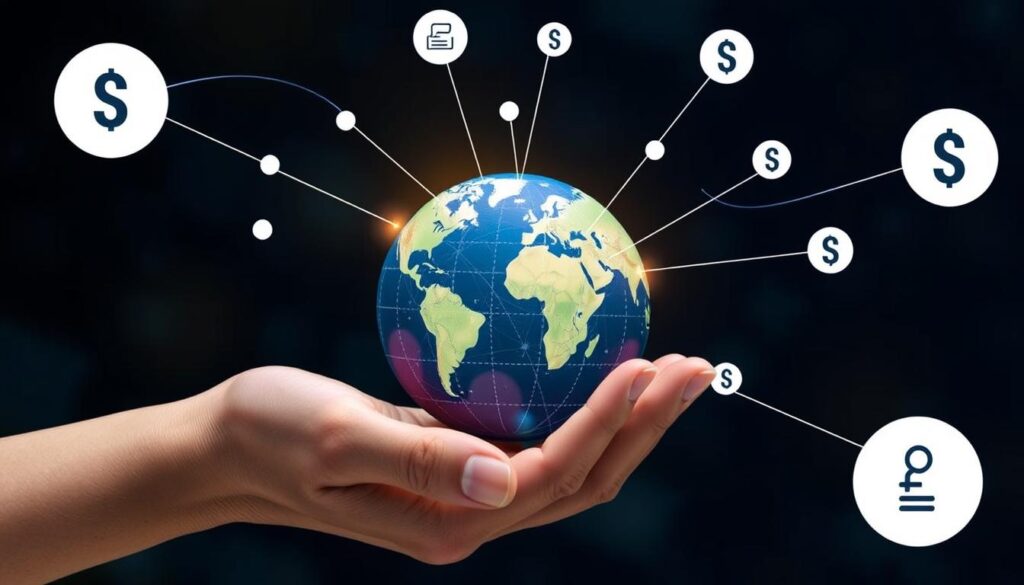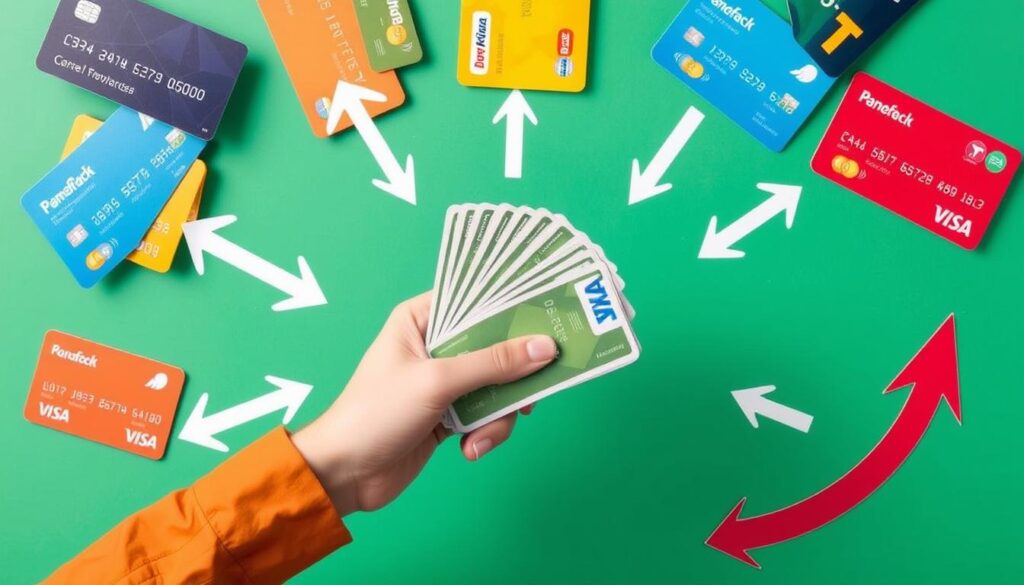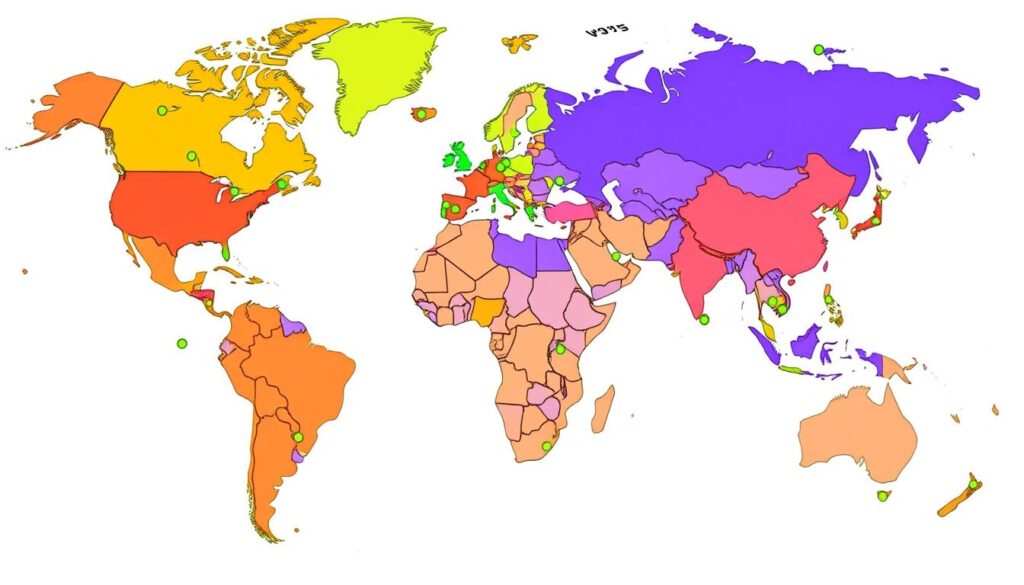In today’s digital age, sending money across borders is key to managing personal finances. But for those without a bank account, it can seem tough. A recent survey found over 9 million U.S. adults don’t have a bank account. They struggle with moving money abroad.
Don’t worry, there are ways to send money without a bank account. You can use prepaid cards, cash transfers, mobile wallets, and postal money orders. This article will cover these options for those without a bank account. We’ll talk about what to think about, like how much you’re sending, how fast you need it there, and where it’s going. Plus, we’ll highlight the best services for this group.
Key Takeaways
- The U.S. is the leading sender of international remittances, with $75 billion transferred annually.
- Transferring money internationally can be costly, with the average transfer fee exceeding 6% of the total amount.
- Several digital and cash-based options exist for sending money without a traditional bank account, including prepaid cards, mobile wallets, and postal money orders.
- When choosing a money transfer service, consider factors like transfer amount, speed, and destination country.
- Popular money transfer services for the unbanked include Western Union, MoneyGram, Xoom, and OFX.
Introduction to Sending Money Internationally Without a Bank Account
The Importance of Money Transfers in the Digital Age
In today’s digital world, sending money across borders is more important than ever. Global trade and the world’s connection have made it crucial to send money fast and safely. People send money for many reasons, like helping family back home, paying for goods from other countries, or sending earnings to families.
The Challenges of Not Having a Bank Account
But, for those without bank accounts, sending or getting money abroad is hard. They have fewer ways to send money and it often costs more. This group, called the “unbanked,” has to find special ways to send and receive money.
The Reserve Bank of India’s Liberalised Remittance Scheme (LRS) lets people send up to $2.5 lakh a year abroad. Most people in India use online to send money, and a new way called online wire transfers is cheaper thanks to banks.
| Transfer Method | Processing Time | Typical Fees |
|---|---|---|
| Online Wire Transfers | 3-7 days | $40-$50 |
| Cashier’s Cheques and Bank Drafts | Longer than online transfers | Varies by bank |
| Mobile Wallet Transfers | Instant | Varies by service provider |
When sending money without a bank account, think about exchange rates and fees. They affect the cost and how well the transfer works.

Send Money Internationally Without a Bank Account
If you don’t have a traditional bank account, you can still send money abroad. You can use prepaid or credit cards to fund your transfers. Or, you can do cash transfers in person at agent locations.
Using Prepaid or Credit Cards
Prepaid cards and credit cards without a bank link let you send money abroad. You load funds on these cards and then send money. The money can be picked up in cash or put into a bank account by the recipient. This method might cost extra, but it’s easy to use for sending money across borders.
Sending Cash In-Person
For those without bank access, cash in-person transfers are another choice. With services like Western Union, you go to an agent, give the person you’re sending to details, and pay in cash. The person you’re sending to can then get the money in cash at an agent in their country. This is great for those who don’t use digital payments.
When sending money without a bank account, think about how fast it will go, the fees, and what options are available in the country you’re sending to.
| Transfer Method | Average Fees | Delivery Speed |
|---|---|---|
| Prepaid/Credit Card | Varies, including potential card issuer fees | Same-day or next-day |
| Cash-based In-Person | $0 to $5+, depending on transfer amount | Same-day or next-day |
| Money Orders | $0.50 to $5+ | 3-7 business days |

Knowing the options and their benefits helps unbanked people pick the best way to send money abroad safely and easily.
Receiving Money Without a Bank Account
In today’s digital world, getting money without a bank account is key. A great way for those without a bank account is to pick up cash at agent locations. This lets people get their money easily, without needing a bank account.
Cash Collection at Agent Locations
Services like Western Union and MoneyGram let you collect cash at many agent spots around the globe. You can find these spots in places like post offices, stores, and special money transfer places.
To get money at an agent spot, you usually need a special code or ID. This easy process makes sure your money gets to you safely and fast. It’s a good choice for people without a bank account.
| Service | Cash Pickup Cost | Transfer Speed |
|---|---|---|
| Western Union | Around $12 for a $200 transfer within the U.S. or Canada, and $22 for a transfer to the U.K. | Rapid, often within minutes |
| MoneyGram | Fees vary based on the transfer amount, speed, and destination | Typically fast, with many same-day options |
Getting cash at agent locations is a big help for those without bank access. It makes getting money easy and safe. This way, the unbanked can handle their money needs well.

Mobile Wallet Transfers
In today’s world, mobile wallet transfers have changed how we send and receive money. They let people without bank accounts join the global financial world easily. This is a big step forward in making money transfers simple and accessible.
How Mobile Wallet Transfers Work
Mobile wallets send money straight to the other person’s phone, linked to their number. This way, it’s faster and easier than old-school bank transfers. Often, the money moves in just minutes.
Benefits of Mobile Wallet Transfers
- Increased Accessibility: These transfers help the unbanked by offering a safe and easy way to send mobile money.
- Faster Transactions: Mobile wallet transfers are quicker than bank ones, finishing in minutes.
- Improved Convenience: You can send and get money right from your phone, skipping bank branches and high fees on digital remittances.
- Lower Fees: These transfers usually cost less than traditional services, making them a better choice for unbanked money transfers.
The digital change is making mobile wallet transfers a key solution for those without bank access. By using phones everywhere, these mobile wallet transfers are changing how people move money across borders.
Postal Money Orders
In today’s digital world, many people don’t have bank accounts. For these individuals, sending money abroad can be hard. But, postal money orders are a safe and easy way to send money without using cash or personal checks.
Postal money orders from the United States Postal Service (USPS) are great for sending international remittances without a bank account. You can send up to $700 in one postal money order. There’s no limit on how many you can send to someone. But, sending international postal money orders costs money, with a minimum fee of at least $10.
To send money using a postal money order, go to a post office and fill out the form. The person getting the money can cash it at a post office or a place that’s allowed to cash it in their country. This method is secure and easy for sending money across borders without a bank account.
Postal money orders might take longer than other ways to send money online. But, they are a good choice for people without bank accounts. Knowing how to use postal money orders helps people make smart choices when sending money abroad without a bank account.
“Postal money orders offer a safe and accessible option for international remittances, especially for the unbanked population.”
Factors to Consider When Sending Money Without a Bank Account
When you send money abroad without a bank account, you need to think about a few things. The amount you’re sending, how fast you need it to go, and where it’s going matter a lot. Each can change what options you have and how much it costs.
Transfer Amount
The amount you’re sending is very important. Many services have limits on how much you can send at once. These limits can be from $2,999 to $50,000, based on the service and the documents you provide. Sending more money might mean paying more fees, so check the costs for your transfer size.
Speed of Transaction
How fast you need the money to arrive is also key. Some services can get it to the recipient the next business day. Others might take a few days. Faster options usually cost more, so think about what you need in terms of speed versus cost.
Destination Country
The country you’re sending money to can affect your options and costs. Some services might not work in all countries or might charge more for certain places. Make sure to look into the services and fees for where you’re sending money.
| Factor | Considerations | Average Costs |
|---|---|---|
| Transfer Amount | Daily/per-transaction limits Documentation requirements | $2,999 to $50,000 limit Higher fees for larger amounts |
| Speed of Transaction | Delivery time (next business day to several days) Faster transfers often cost more | $2 to $6.42 for online transfers Higher fees for cash pickup services |
| Destination Country | Coverage and availability of services Potential for higher fees | Varies by provider and country Up to 5% plus conversion fee |
Think about these important factors to choose the best way to send money abroad without a bank account. You want to balance cost, speed, and convenience for your needs.
Popular Money Transfer Services for Unbanked Transfers
In today’s digital world, many money transfer services have come up to help those without bank accounts. They make it easy for people without banks to send and receive money across borders.
Hawala is an old way to send money that started in South Asia in the 8th century. It’s still big in the Islamic world. Even though some places have banned it, new fintech companies are bringing it back to help those without banks.
Mobile Wallet Transfers are also big now. They let people send and get money with their phones. This is great for those who don’t have bank accounts.
Money Orders are still a top choice in places like India where many don’t have banks. The Reserve Bank of India watches over them. They’re used a lot for sending money inside and outside the country.
When picking a money transfer service, think about how fast it is, how easy it is for the person getting the money, how much it costs, and how safe it is. Looking into different services can help you pick the best one for your needs and money situation.
“Financial inclusion is not just about bank accounts. It’s about providing a range of financial services to those who have been excluded from the formal financial system.”
The need for easy and cheap ways to send money across borders is growing. So, the options for unbanked people will keep getting better. This means more ways for people to manage their money and help their families from far away.
Western Union for Unbanked Money Transfers
Western Union is a top choice for sending money worldwide, even if you don’t have a bank account. They offer easy ways to send and receive money, like cash pickup and mobile wallet transfers. These options are great for people who don’t use traditional banks.
Cash Pickup and Mobile Wallet Options
Western Union has over 500,000 agent locations around the globe. This makes it easy to pick up cash without a bank account. The person getting the money just needs to show ID and the Money Transfer Control Number (MTCN) at a Western Union agent.
For those with a mobile wallet, Western Union also lets you send money straight to it. This means you don’t need a bank to send money. Just use the person’s phone number to send cash, making it easy and hassle-free.
A 2021 FDIC study found that many unbanked households use prepaid debit cards. This shows how important alternative banking options are. Western Union offers flexible ways to send money, helping those who don’t use traditional banks.
Whether you like picking up cash or using mobile wallets, Western Union has you covered. Their services make sure your money gets to where it needs to go fast and safely, without needing a bank account.
MoneyGram for International Remittances Without Bank Accounts
MoneyGram is a key service for sending money across borders without a bank account. It serves people who don’t have bank accounts. With agents all over the world, it makes sending money easy and accessible.
MoneyGram works in all 50 states, the District of Columbia, and U.S. territories. It has many licenses, like a Money Transmitter License from New York. It’s also registered with the Nationwide Mortgage Licensing System and licensed by the Georgia Department of Banking and Finance.
| Key MoneyGram Features | Details |
|---|---|
| Send Limits | In the U.S., you can send up to $10,000 per online transfer to most countries. Money orders let you send no more than $1,000. |
| Fees | MoneyGram’s fees are often higher than those of traditional money orders. Sending $200 to various countries costs between $206 and $214. |
| Payment Methods | Debit cards are recommended for quick transfers, but cash is also accepted. Using a credit card might add extra fees. |
| Delivery Options | Transactions can be as quick as a few minutes or take a few days, depending on the payment and receive methods chosen. |
The MoneyGram mobile app is a fast, easy, and affordable way to send money. It’s supported by over 80 years of global money transfer experience. The app has TouchID and FaceID login, rewards, and bill payment options. It’s great for those without bank accounts or traditional banking access.
MoneyGram is available in over 200 countries and territories, but currency support and transfer limits can change by destination. With its wide network and digital tools, people without bank accounts can easily send and receive money internationally. This ensures they stay connected and financially included in today’s digital world.
Xoom: PayPal’s Cross-Border Money Transfer Service
In today’s digital age, sending money across borders is more important than ever. If you don’t have a bank account, Xoom, a PayPal service, is a great option. It helps you send money worldwide without needing a bank account.
Xoom reaches about 160 countries, offering a way to send money without extra fees. When you use PayPal USD to send money to friends or family, there are no fees. This makes Xoom a smart choice for those looking to save money when sending money abroad.
You can pay with debit cards, credit cards, or bank accounts through Xoom. This flexibility meets the different financial needs of its users. For example, sending 1 USD to India costs only 83.0818 INR, which is a good deal for those with family or friends there.
| Payment Method | Fee |
|---|---|
| Debit Card | $8.69 |
| Credit Card | $30.49 |
Xoom also has fast transfer options. You can get cash in minutes or have money deposited in a bank in 2 hours for up to 5 lakh. This is great for urgent money transfers.
Xoom keeps your transactions safe with encryption and fraud monitoring. They protect your money 24/7. Plus, customer support is available in many languages, helping a wide range of users.
The Xoom app makes sending money internationally easy, even if you don’t have a bank account. With PayPal’s support, Xoom offers a secure and dependable way to send money across borders.
OFX for Bank Account to Bank Account Transfers
OFX is great for sending money from one bank account to another around the world. It offers secure and affordable ways to send money globally. This is especially helpful for people without traditional bank accounts.
Using OFX means you get clear info on fees and exchange rates. Up to 80% of people don’t know banks charge up to 5% more than the daily rate for international transfers. OFX, on the other hand, doesn’t charge fees for sending money in USD. This can save you up to $500 on a $10,000 transfer compared to using a bank.
| Feature | OFX | Banks |
|---|---|---|
| Average Cost of International Transfers | 6% of the amount sent | Up to 11% (including high exchange rate margins) |
| Transfer Limits | No maximum transaction or daily limits | May impose limits |
| Transfer Speed | Same-day or 1-2 business days for major currencies | Varies, often slower than OFX |
| Customer Support | 24/7 availability | Limited support hours |
OFX also offers over 50 currencies for sending money internationally. They give special rates for big transfers and for businesses. This means both individuals and companies can save money with OFX.
For those without a traditional bank account, OFX’s services are a big help. With over 25 years of experience, OFX is a trusted choice for sending money safely around the world. Even for those without a bank account, OFX is a reliable option.
“OFX has been a lifesaver for my business. The 24/7 customer support and fee-free transfers have made managing our international payments so much easier.”
Whether you’re an individual or a business owner, OFX makes sending money globally easy and affordable. You don’t need a traditional bank account to use their services.
Send Money Internationally Without a Bank Account
Digital remittance services have made sending money abroad easier, even if you don’t have a bank account. These services offer many benefits for people without traditional bank accounts.
One big plus is how fast they work. Wise, a top digital remittance service, sends over half of its transfers in less than 20 seconds. This fast service lets you send money quickly, helping your loved ones in a hurry.
Another advantage is how cost-effective these services are. Wise moves $11 billion each month, offering great exchange rates and low fees. This makes it easier for you to help your family and friends overseas.
These services also support many currencies, over 40 to be exact. This means you can send money almost anywhere in the world. It’s great for meeting the varied needs of your family and friends abroad.
Security and ease of use are key for these services. They use HTTPS encryption, 2-step verification, and have teams to fight fraud. Wise even offers FDIC insurance up to $250,000, so you can send money safely.
In summary, digital remittance has changed how we send money abroad without a bank account. With their speed, low costs, wide reach, and strong security, these services make it easy to support your loved ones from afar.
| Key Features | Wise |
|---|---|
| Delivery Speed | Over 50% of transfers in under 20 seconds |
| Monthly Transaction Volume | $11 billion |
| Interest Earned | 4.95% Annual Percentage Yield (APY) on USD balances |
| FDIC Insurance | Passthrough coverage up to $250,000 on eligible balances |
| Currency Options | Over 40 currencies supported |
| Security Features | HTTPS encryption, 2-step verification, dedicated fraud and security teams |
“Digital remittance platforms have made it easier and more convenient than ever to support your loved ones across borders.”
Conclusion
This article looked at ways to send money abroad without a bank account. You can use prepaid cards, cash transfers, mobile wallets, and postal money orders. These options help people without bank accounts send money safely and easily.
The digital world has brought new ways to send and receive money with phones. Now, people without banks can use gift cards, money orders, online payments, cryptocurrencies, eWallets, or prepaid debit cards. These methods are both affordable and secure for sending money across borders.
When choosing how to send money, look at speed, cost, and security. Make sure you have the right info about the person you’re sending money to. Companies like Western Union, MoneyGram, and Xoom offer cash pickup and mobile wallet services for easy money transfers abroad. Thanks to digital remittances, sending money without a bank account is now simpler than before.
FAQ
How can I send money internationally without a bank account?
You can send money without a bank account by using prepaid or credit cards. You can also send cash in-person, use mobile wallets, or send postal money orders.
What are the advantages of using mobile wallets for international money transfers without a bank account?
Mobile wallets are fast, easy to use, and reach people without bank accounts. They let you send and receive money digitally, without needing a traditional bank account.
What factors should I consider when sending money internationally without a bank account?
Think about how much you’re sending, how fast you need it to go, and where it’s going. These things affect your options and the cost.
What are some of the top money transfer services that cater to the unbanked population?
Great options for those without a bank account include Western Union, MoneyGram, Xoom (owned by PayPal), and OFX. Each service has its own special features and ways of delivering money.
What are the benefits of using digital remittance services for international money transfers without a bank account?
Digital remittance services are convenient, fast, and save money. They let you send money worldwide, even if you don’t have a traditional bank account.



